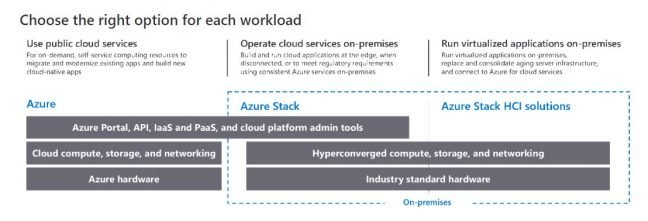Microsoft enables end users to run virtualized applications on premise on modern Hyper-Converged Infrastructure (HCI) applications while at the same time benefiting from public cloud services, in this case Azure. The tech giant has now launched Azure Stack HCI Solutions.
According to the tech giant, the now launched Azure Stack HCI Solutions are an evolution of already available Windows Server Software-Defined (WSSD) solutions that were previously available from different partners.
It’s also an extension of Azure Stack solutions presented in 2017, enabling end users to use cloud-based applications based on iPaaS and PaaS services within both unconnected edge locations, on-premise data centers or Azure’s public cloud.

Virtualized applications, on-premise and cloud connectivity
In concrete terms, Azure Stack HCI Solutions’ now launched solutions mean that companies and organizations can now also run virtualized applications on premise in a HCI environment, while at the same time having access to cloud-based services.
Azure Stack HCI solutions use the same software-defined compute, storage and network software as in Azure Stack. It also seamlessly integrates with Azure for hybrid solutions such as cloud-based backup, site recovery and monitoring services. In total, about 70 of these services are already available.
Conditions and hardware combinations
To be able to run Azure Stack HCI Solutions, it is important that end users have the Windows Server 2019 Datacenter Edition and Windows Admin Center solutions at their disposal.
It is also not possible to upgrade from Azure Stack HCI Solutions to Azure Stack at a later stage. However, the end users of the HCI solutions now presented can migrate their workloads to Azure Stack. Or to the Azure cloud environment, of course.
Azure Stack HCI Solutions are already available in conjunction with hardware from 15 different vendors, including ASUS, Axellio, bluechip, DataON, Dell EMC, Fujitsu, HPE, Hitachi, Huawei, Lenovo, NEC, primeLine Solutions, QCT, SecureGUARD and Supermicro.
This news article was automatically translated from Dutch to give Techzine.eu a head start. All news articles after September 1, 2019 are written in native English and NOT translated. All our background stories are written in native English as well. For more information read our launch article.